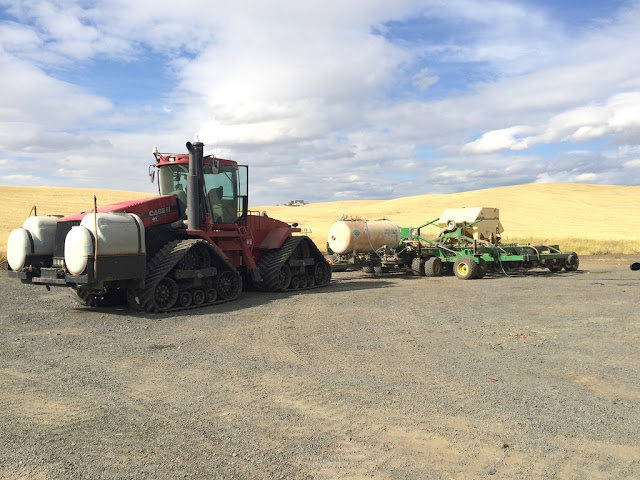So last week I was on a Fertilizer Mission out in the Palouse area of the Pacific Northwest. (And fyi: the "louse" part rhymes with "loose". So don't be a louse and say it wrong.) I have written about it in the blog before, but in the summer when all was green with fields of wheat and field peas. It is a region of hills and valleys formed back in the Ice Ages that covers SE Washington, NC Idaho and parts of E Oregon. The area is also called the Inland Empire. But it is very unique and has intensive farming, so a good place for using AgroLiquid.
I flew into Spokane, WA and was met by Field Agronomist JW. We just had to have dinner that night at my favorite restaurant there called Anthony's. It overlooks Spokane falls and has great seafood. I have shown this view before when it was sunny. In fact the whole week was mostly cloudy and cool.
Spring and winter wheat harvest is in the past now leaving fields in various conditions awaiting seeding of winter wheat. These pics don't really show how steep the slope is and it's hard to believe how there aren't more field equipment turnovers. But the Quad Trac tractor is quite common as are combines with self leveling heads. Now a lot of the ground is not worked in between crops as seen here.
But a lot of it is still tilled, as it has been for many years. You will often see this where low ground is worked but the slopes are not. But also fields where even steep ground is worked.
And on dry and windy days, this is what a tillage operation looks like. There is a tractor and tillage tool in there somewhere.
Well there is a fine organization called the Pacific Northwest Direct Seed Association (PNWDSA) working to un-promote tillage. Direct Seeding is like No-Till, where the crop is seeded directly into the undisturbed ground. Saves time, fuel, money, moisture and as we saw above, soil. With vast improvements in drill technology, the crop grows very well. Go their annual conference in January to learn more. (By the way, JW used to work for the USDA surveying land in this area. He would measure fields and flag grass borders on the sides of hills like this that are too steep to farm. Certainly a young man's job, but I'm sure JW will say that he can still do it.)
In fact we spent some time with Kay Meyer who is the Executive Director of the PNWDSA. She was kind enough to attend one of the Research Field Days, and invited me out to see them. So I did! She is well connected and we had some meetings with some researchers at the University of Idaho to introduce AgroLiquid products and discuss options. Here Kay studies some of the soil monoliths on display at the agronomy building. Very cool. We also met with some folks at nearby Washington State University. Those two schools are only eight miles apart which is a unique situation.
Kay took us around to meet and greet some area growers like this one in Idaho. You can see in the background that he is a direct seeder. This is the Ag Pro direct seed conservation drill that he uses. It applies three different types of fertilizer. An in-furrow liquid, some ATS and dissolved KCl and we won't discuss the gas tank. But we will see how some AgroLiquid compares.
You know I'm always up for seeing some sights throughout my travels. Like in the small town of Uniontown is the first Catholic church of Washington. It was built by the mostly German farmers who moved West from Minnesota in the late 1800's. It was started in 1882 and after a delay, opened in 1905. Still open today. Very pretty.
And here is a pretty view of the scenery looking over lavender plants, from the farm where Kay and her husband live near Uniontown in Colton. (Kind of twin cities, or towns, I guess.) She and her husband are the fifth generation living in the house there. They have really landscaped the grounds and have a site that hosts country weddings in their big red barn. Nothing wrong with diversification like that, plus it brings people out to see agriculture.
So after a week, it was time to say goodnight to the Palouse.
Already looking forward to my next trip.










